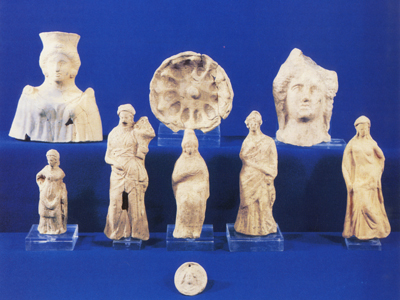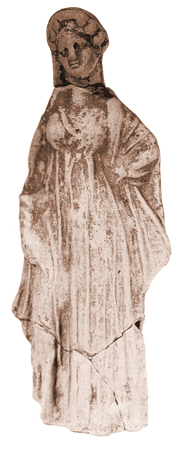The sacred area of St. Marcusby Paola Bottini
The south area of Grumentum walls since long time was known as place of burials of Roman age, and for being crossed both by the aqueduct that supplied the city and by a road network that connected the area of Potenza and the Agri Valley with the Tyrrhenian area of the region; its denomination derives from that one locally given to the remains of a wide basilica with three aisles. In 1992, the preliminary surveys for the construction of a new museum, apart from confirming the presence of a necropolis in sync with the constitution of the urban setting and highlighting a bifurcation of the aqueduct, brought to light a votive deposit dating back to pre-Roman age. The materials that were part of it had been buried in a large grave of elongated shape; the covering made with stones and brick fragments, as well as with mold, helped to limit the damages caused by agricultural works in recent times.
However there are many more statuettes with prevalence of female sitting figures, depicted with slight variations in details. The most common of all is a draped figure, whose “step” structure requires a throne or a seat, which is not represented; with right hand holds on the chest the folds of coat, while the left one, leaning on the lap, holds a fruit (or also a small animal); hair is styled in a high bon on her head, and ears are adorned with earrings.
A vaster variety of types can be found in the female standing figurines, some of which have a base, plinth or circular; it is an unique model the statuette of an offering with piglet and torch, whereas in more models recurs the draped figure holding with left arm a flower basket. But a particular place is up to a figure that distinguishes from the others not only for its size (not less than 45 centimeters in height), but also for wide movement and richness of the drapery. The long chiton, typical of the Greek goddess Artemis, and the animal skin covering it, typical of the Thracian goddess Bendis, induce to identify it with the divinity in which are combined both characters, present in Basilicata - as in many other shrines of Magna Graecia – with the name of Mefitis, and to believe that the statue was just image of the cult given in the sacred area of Grumentum. To define the characters of divine figure also contribute the clay medallions, with female protome on one of the two faces. The frame of clay products is completed with a few other items, including a matrix that was used to reproduce an umbilicate goblet. Ceramics are in a minority presence compared with terracotta: include pottery both black painted and achromatic, whereas we don’t have any traces of figured material; fragments of pots maybe are in relation to the direct offer of food. There are only two exemplars of miniaturist pottery; also clay incense burners are just a few, as well as metal, bronze and iron objects. There are only four coins, but very important for dating the deposit: one from Terina, silver, it’s a kind dating back to late fourth century B.C., while two bronze coins from Agathocles of Syracuse (with head of Artemis on the right side and winged lighting on the opposite) belong to a series minted not before 304 B.C. The rural sanctuary to whom is referred the deposit, located not too far from some water sources, was therefore dedicated to a goddess represented as Artemis-Bendis as well as Demetra/Kore, but also with some proper characters of Aphrodite, summarizing in a single figure the functions of divinity anyway related to the productive and reproductive cycle of nature. The burying epoch of votive offerings is certainly later than the dates of the two Agathocles coins, but -on the basis of materials in their complex- doesn’t seem to go beyond the half third century B.C.: that is the time of Grumentum city’s birth, and also the beginning of using St. Marcus area as a necropolis.
Copyright text and pictures (where there aren’t other references) by Paola Bottini |




 The
The 